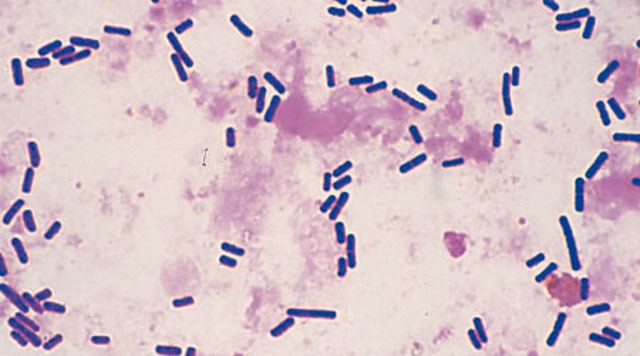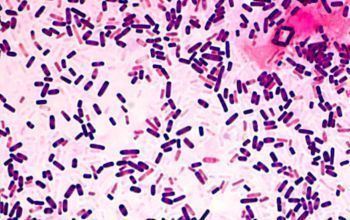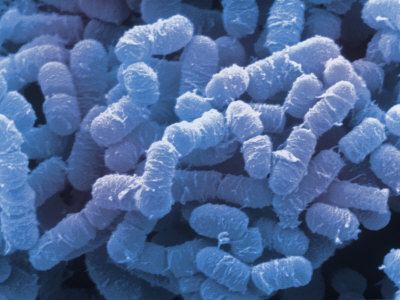Rank Species | Higher classification Clostridium | |
Similar | ||
Clostridium perfringens video educativo
Clostridium perfringens (formerly known as C. welchii, or Bacillus welchii) is a Gram-positive, rod-shaped, anaerobic, spore-forming pathogenic bacterium of the genus Clostridium. C. perfringens is everpresent in nature and can be found as a normal component of decaying vegetation, marine sediment, the intestinal tract of humans and other vertebrates, insects, and soil. It has the shortest reported generation time of any organism at 6.3 minutes in thioglycollate medium.
Contents
- Clostridium perfringens video educativo
- Gangrena gaseosa clostridium perfringens
- Motility
- Food poisoning
- Infection
- Diagnosis
- Prevention
- Food poisoning incidents
- References

C. perfringens is the third most common cause of food poisoning in the United Kingdom and the United States though it can sometimes be ingested and cause no harm.

infections due to C. perfringens show evidence of tissue necrosis, bacteremia, emphysematous cholecystitis, and gas gangrene, which is also known as clostridial myonecrosis. The toxin involved in gas gangrene is known as α-toxin, which inserts into the plasma membrane of cells, producing gaps in the membrane that disrupt normal cellular function. C. perfringens can participate in polymicrobial anaerobic infections. Clostridium perfringens is commonly encountered in infections as a component of the normal flora. In this case, its role in disease is minor.
The action of C. perfringens on dead bodies is known to mortuary workers as tissue gas and can be halted only by embalming.

Gangrena gaseosa clostridium perfringens
Motility

Although they lack flagella, C. perfringens bacteria are able to glide across surfaces because their bodies are lined with filaments from end-to-end. The hypermotile variants such as SM101, are often found arising on the edges of colonies on agar plates. Video microscopy of their gliding movement suggest that they form long, thin filaments that allow them to move rapidly like bacteria with flagella. genome sequencing was used to identify the cause(s) of the hypermotile phenotype and their direct derivatives. In comparing them, strains SM124 and SM127, hypermotile derivatives of strains SM101 and SM102, respectively, contained 10 and 6 nucleotide polymorphisms (SNPs) relative to their parent strains. Mutations in cell division genes is the common feature of the hypermotile strains.
Food poisoning

In the United Kingdom and United States, C. perfringens bacteria are the third most common cause of foodborne illness, with poorly prepared meat and poultry, or food properly prepared but left to stand too long, the main culprits in harboring the bacterium. The clostridium perfringens enterotoxin (CPE) mediating the disease is heat-labile (inactivated at 74 °C (165 °F)). It can be detected in contaminated food (if not heated properly), and feces. Incubation time is between six and 24 (commonly 10–12) hours after ingestion of contaminated food.

Since C. perfringens forms spores that can withstand cooking temperatures, if cooked food is let stand for long enough, germination can ensue and infective bacterial colonies develop. Symptoms typically include abdominal cramping, diarrhea, vomiting, and fever. The whole course usually resolves within 24 hours, but can last up to two weeks in older or infirm hosts.

Perfringens poisoning can also lead to another disease known as enteritis necroticans (also known as pigbel); this is caused by the same strain that causes perfringens food poisoning. However this infection is often fatal. Large numbers of C. perfringens grow in the intestines, and secrete exotoxin. This exotoxin causes necrosis of the intestines, varying levels of hemorrhaging and perforation of the intestine. Inflammation usually occurs in sections of the jejunum, midsection of the small intestine. This disease eventually leads to septic shock and death. This particular disease is rare in the United States; typically it occurs in populations with a higher risk. Risk factors for enteritis necroticans include protein-deficient diet, unhygienic food preparation, sporadic feasts of meat (after long periods of a protein-deficient diet), diets containing large amounts of trypsin inhibitors (sweet potatoes), areas prone to infection of the parasite Ascaris (produces a trypsin inhibitor). This disease is contracted in populations living in New Guinea, parts of Africa, Central America, South America and Asia.

Many cases of C. perfringens food poisoning likely remain subclinical, as antibodies to the toxin are common among the population. This has led to the conclusion that most of the population has experienced food poisoning due to C. perfringens.
Despite its potential dangers, C. perfringens is used as the leavening agent in salt rising bread. The baking process is thought to reduce the bacterial contamination, precluding negative effects.
Infection
Clostridium perfringens is the most common bacterial agent for gas gangrene.
Research published in 2014 suggested that a strain of C. perfringens might be implicated in multiple sclerosis (MS). Tests in mice found that a toxin made by a rare strain of C. perfringens caused MS-like damage in the brain, and earlier work had identified this strain of C. perfringens in a human with MS. MS patients were found to be ten times more immune-reactive to the epsilon toxin than healthy people.
Diagnosis
C. perfringens can be diagnosed by Nagler's reaction where the suspect organism is cultured on an egg yolk media plate. One side of the plate contains anti-alpha-toxin, while the other side does not. A streak of suspect organism is placed through both sides. An area of turbidity will form around the side that does not have the anti-alpha-toxin, indicating uninhibited lecithinase activity. In addition, laboratories can diagnose the bacteria by determining the number of bacteria in the feces. Within the 48 hours from when the disease began, if the individual has more than 106 spores of the bacteria per gram of stool, then the illness is diagnosed as C. perfringens food poisoning. Other tests/reactions: Catalase: Negative, Spot indole: Positive, Lecithinase: Positive, Lipase: Negative, Litmus Milk: Stormy Fermentation, Reverse CAMP plate: Positive, Gas Liquid Chromatography products: (Acetic, Butyric and Lactic Acids).
Typically, the symptoms of C. perfingens poisoning are used to diagnose it. However, diagnosis can be made using a stool culture test, in which the feces is tested for toxins produced by the bacteria.
Prevention
The growth of C. perfringens spores can be prevented by most importantly cooking food, especially beef and poultry, thoroughly to the recommended temperatures. Leftover food should be refrigerated to a temperature below 40 °F (4 °C) within the two hours of preparation. Large pots of food like soup or stew with meats should be divided in small quantities and covered for refrigeration. Leftovers should be reheated to at least 165 °F (74 °C) before serving. A general rule of thumb is that if the food tastes, smells, or looks different from what it is supposed to then the food should be avoided. Even if it looks okay, a food that has been out for a long time can also be dangerous to eat.
Food poisoning incidents
On May 7, 2010, 42 residents and 12 staff members at a Louisiana state psychiatric hospital experienced vomiting, abdominal cramps, and diarrhea. Within 24 hours, three patients had died. The outbreak was linked to chicken which was cooked a day prior to being served and was not cooled down according to hospital guidelines. The outbreak affected 31% of the residents of the hospital and 69% of the staff who ate the chicken. It is unknown how many of the affected residents ate the chicken.
In May 2011, a man died after allegedly eating food contaminated with the bacteria on a transatlantic American Airlines flight. The man's wife and daughter are suing American and LSG Sky Chefs, the German company that prepared the inflight food.
In December 2012, a 46-year-old woman died two days after eating a Christmas Day meal at a pub in Hornchurch, Essex, England. She was among about 30 people to fall ill after eating the meal. Samples taken from the victims contained C.perfringens. The hotel manager and the cook were jailed for offences arising from the incident.
In December 2014, 87-year-old Bessie Scott died three days after eating a church potluck supper in Nackawic, New Brunswick, Canada. Over 30 other people reported signs of gastrointestinal illness, diarrhea and abdominal pain. The province's acting chief medical officer says Clostridium perfringens is the bacteria that most likely caused the woman's death.
In November 2016, food contaminated with Clostridium perfringens caused three individuals to die, and another 22 to be sickened, after a Thanksgiving luncheon hosted by a church in Antioch, California.
